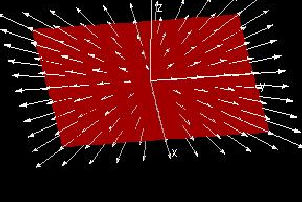|
Vector Fields, Curl and Divergence
Text A vector field is defined by a function which associates a vector with each
point in the domain of the function.

In two dimensions, a vector field V can be expressed in terms of the functions p(x,y) and q(x,y) as V(x,y) = (p(x,y),q(x,y)).
Note that for the gradient vector field, p = fx and q = fy.

The divergence of a vector field V(x,y) = (p(x,y),q(x,y)) is defined as div V = ∇ ⋅ V = px + qy.
 Note that divergence of a vector field is a scalar value.
Note that divergence of a vector field is a scalar value.

The scalar curl of a two-dimensional vector field is defined as scalar curl V = -py(x,y)+qx(x,y).
 The curl of a vector field V is usually defined for a vector field in three variables by the condition curl V = ∇ x V. If the third coordinate is 0, then curl(p(x,y),q(x,y),0) = ∇ {times} (p(x,y),q(x,y),0) = (0,0,qx-py). The third coordinate, -py(x,y)+qx(x,y) is called the scalar curl of V. The scalar curl of a vector field in the plane is a function of x and y and it is often useful to consider the function graph of the (x,y,-py(x,y) + qx(x,y)).
The curl of a vector field V is usually defined for a vector field in three variables by the condition curl V = ∇ x V. If the third coordinate is 0, then curl(p(x,y),q(x,y),0) = ∇ {times} (p(x,y),q(x,y),0) = (0,0,qx-py). The third coordinate, -py(x,y)+qx(x,y) is called the scalar curl of V. The scalar curl of a vector field in the plane is a function of x and y and it is often useful to consider the function graph of the (x,y,-py(x,y) + qx(x,y)).

If a two-dimensional vector field F(p,q) is conservative, then its curl is identically zero since py = qx, ∇ {times} F = (0,0,qx-py) = (0,0,0).
Demos
Divergence and Curl in 2D

| 
|
This demo shows, in the first window, the vector field V(x,y). In the "Divergence" window, the z-coordinate of the red surface indicates the value of the divergence at (x,y): div((x,y)) = f(x,y) = z. In the "Curl" window, the z-coordinate of the green surface indicates the value of the scalar curl at (x,y). 
|
|